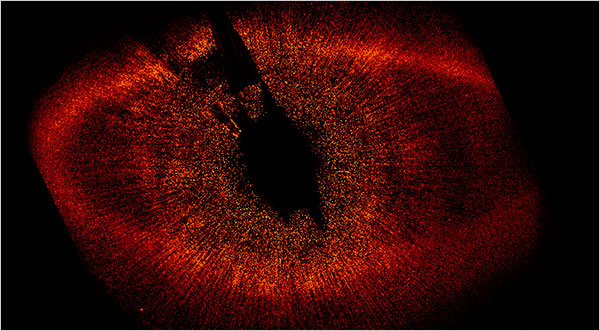A_Wanderer
ONE love, blood, life
The first images of extrasolar planets are in
The same elements exist throughout our galaxy and the universe, physical laws are probably the same everywhere and soon we will be able to pinpoint places where life might arise; a very exiting time to be alive.
http://www.nytimes.com/2008/11/14/s...bl&ex=1226725200&en=8493bad0556dcca4&ei=5087In what might amount to an early Christmas present to the universe, two groups of astronomers have taken the first pictures of what they say — and other astronomers agree — are probably planets going around other stars.
The achievement, the result of years of effort on improved observational techniques and better data analysis, presages more such discoveries, the experts said, and will open the door to new investigations and discoveries of what planets are and how they came to be formed.
“It’s the tip of iceberg. Now that we know they are there, there is going to be an explosion,” said Christian Marois of the Herzberg Institute of Astrophysics in Victoria, British Columbia. Dr. Marois is the leader of a team that recorded three planets circling a star — known as HR 8799 — 130 light-years away in the constellation Pegasus.
The other team, led by Paul Kalas of the University of California, Berkeley, found a planet orbiting the star Fomalhaut, only 25 light-years from Earth, in the constellation Piscis Austrinus. In an interview by e-mail, Dr. Kalas said that when he finally confirmed his discovery last May, “I nearly had a heart attack.”
In scratchy telescope pictures released to the world Thursday in Science Express, the online version of the journal Science, the new planets appear as fuzzy dots that move slightly around their star from exposure to exposure. Astronomers who have seen the new images agreed that these look like the real thing.
“I think Kepler himself would recognize these as planets orbiting a star following his laws of orbital motion,” Mark S. Marley, of NASA’s Ames Research Center in Mountain View, Calif., wrote in an e-mail message elaborating on HR 8799.
More than 300 so-called extrasolar planets have been found circling distant stars, making their discovery the hottest and fastest growing field in astronomy. But the observations have been made mostly indirectly, by dips in starlight as planets cross in front of their home star or by wobbles they induce going by it.
Astronomers being astronomers, they want to actually see these worlds, but a few recent claims of direct observations have been clouded by debates about whether the bodies were really planets or failed stars.
“Every extrasolar planet detected so far has been a wobble on a graph. These are the first pictures of an entire system,” said Bruce Macintosh, an astrophysicist from Lawrence Livermore National Laboratory in California and a member of Dr. Marois’s team.
The new planetary systems are anchored by young bright stars more massive than our own Sun and swaddled in large disks of dust, the raw material of worlds. The three planets orbiting HR 8799 are roughly 10, 9 and 6 times the mass of Jupiter, and orbit their star in periods of 450, 180 and 100 years respectively, all counterclockwise.
The Fomalhaut planet is about three times as massive as Jupiter, according to Dr. Kalas’s calculations, and is on the inner edge of a huge band of dust, taking roughly 872 years to complete a revolution of its star.
Both systems appear to be scaled-up versions of our own solar system, with giant planets in the outer reaches, leaving plenty of room for smaller planets to lurk undetectable in the warmer inner regions. Dust rings lie even farther out, like the Kuiper belt of icy debris extending beyond the orbit of Neptune in our own solar system.
“This is a window into what our own solar system might have looked like when it was 60 million years old,” Dr. Marois said.
Sara Seager, a planetary theorist at the Massachusetts Institute of Technology, said it was significant that that the planets in both cases seemed to be associated with disks of dust, particularly Fomalhaut, one of the brightest and closest stars and one of the “Fabulous Four,” known to be host to a massive disk.
“Fomalhaut is like a Hollywood star to astronomers, so we have some personal excitement here,” she said. “It feels like finding out that one of your four closest friends just won the lottery big time”
Alan Boss, a planetary theorist at the Carnegie Institution of Washington, said the triple-planet system in Pegasus was particularly promising, “as we expect planets to form in systems in general, whereas spurious background interlopers will generally appear as single ‘planets.’ ” But he and others cautioned that much more study of these objects was necessary and that the masses imputed to them were still highly uncertain.
Being able to see planets directly opens the door to spectroscopic observations that can help determine the composition, temperature and other physical characteristics of planets and allow for comparisons with each other and with their parent stars. Dr. Macintosh said that he hoped to train a spectroscope on his new planets as early as Monday.
The same elements exist throughout our galaxy and the universe, physical laws are probably the same everywhere and soon we will be able to pinpoint places where life might arise; a very exiting time to be alive.






